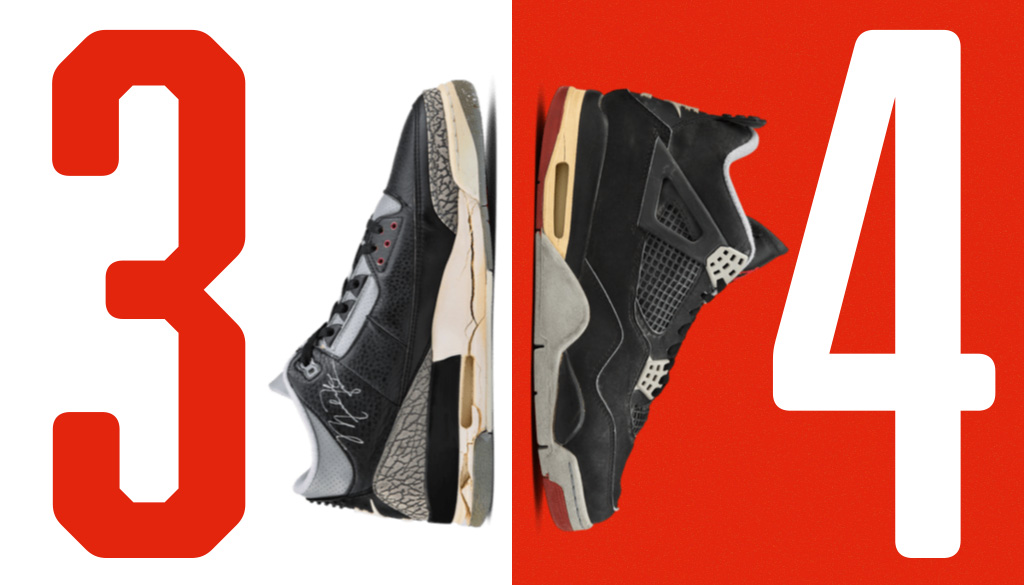There are few sneakers that carry a greater legacy than the Air Jordan 3 and the Air Jordan 4. Both silhouettes play an iconic role in both Michael Jordanâ€
When the two silhouettes were released in the late eighties, they made their debuts at pivotal points of Jordanâ€
Legendary designer Tinker Hatfield intended for the Jordan 4 to be an evolution of the Jordan 3, yet the two silhouettes maintained a key similarity — Nike Air branding on the back heel. When the Air Jordan 4 received its first retro, however, a change in branding created a consequential divide.Â
The Air Jordan 4 returned for the first time in 1999 and released in four colorways: the White Cement, Black Cement (or Bred), Columbia, and Oreo. The latter two colorways, however, were released as Retro+ models — brand new colorways of the storied silhouette. Both included a Jumpman on the back which signified new offerings, not to be confused with the originals.Â
And while there were likely some fans who disapproved of the Jumpman logo, it was the first time that Retro models would be highly sought after. The Air Jordan 1, 2, and 3, were re-released in the early 90s but they didnâ€
Take for example Jerry Lorenzo, founder of luxury streetwear label Fear of God. The sneaker and footwear designer has been more than vocal about his opinion of branding on Jordans.Â
“I donâ€
Zarek Valentin, Houston Dynamo FC defender, and sneakerhead, also points out that having the exact model worn by Jordan, signified by the “Nike Air†logo, is a level of status thatâ€
“In professional soccer, no player has their own signature silhouette of cleats — only individual colourways,†he says. “Contrary to the NBA, wearing Messi or Ronaldo colourways on the pitch is viewed as lame. Thankfully, things are different off the field. Having ‘Nike Airâ€
But while Nike Air branding on the heel may be the unanimous choice, that doesnâ€
“The original Air Jordan 3 and 4 had Nike Air logos on the heel, and thatâ€
“I donâ€
– Jerry Lorenzo
Chris Chase, co-founder of WearTesters, also agrees that while the Nike Air logo may reign supreme, both logos carry their own value and significance.Â
“The Nike Air is what fans from day one recognize,†he tells Sole Savy in an interview. “While some see Jumpman-branded pairs as inferior, I feel it signifies when Michael Jordan became more than just a Nike athlete.â€Â
“He was the brand. Unprecedented at this time, this really was something totally new to fans and consumers.â€
For better or worse, Jumpman branding would ultimately take over the heel of Jordan 4s, retro colourway or not, for close to 20 years. And as the silhouette received more and more releases, the heel logo wasnâ€
When comparing releases in the mid-2000s and early-2010s, “the shape of the shoes were pretty different compared to the original mold,†Go says. Many of them had a “swooping and elongated ‘bananaâ€
The construction of the tongues on both models is another example to show changes in construction over the years. One issue with retros of the Jordan 3, specifically, was that material on the inside of the tongue would often wrap up and over the front, completely unlike the originals.Â
“While the Air Jordan 4 has yet to receive an OG-style tongue on the modern-day retro, the Air Jordan 3 now has the proper shape and cut,†Chase explains. “Even smaller details are being taken care of — like tucking the interior liner of the tongue behind the leather as it was originally.â€Â
Another notable difference includes the toe panels and the height of the toe box. The original silhouettes of both the Jordan 3 and Jordan 4 featured toe boxes that were lower in height, as well as a lower toe tip.Â
It was only in recent years that Jordan 3 and 4 releases would take considerable steps to being closer to the original models. By using less padding on the interior of the shoe, the silhouettes became slimmer and less box-like in shape, much like their original versions. The elephant print used on Jordan 3s has also been improved by using thinner materials — although the print is still heavier and thicker compared to those found on the originals.
Not to mention, it was only in 2019, with the release of the Jordan “Black Cement†that the Nike Air logo would make its return to the heel. This model in particular was exceptionally important — in addition to the heel, it was also the first Jordan 4 to include the original box since 1989.Â
“They’ve done a great job recreating the packaging and tissue paper — that OG feel and experience of opening a brand-new pair of Jordans straight from the 80’s and 90’s,†Chase says. “Materials, on the other hand, are harder to replicate due to many of the older factories no longer operating. They can make the products a bit more premium than what they were, but that could end up frustrating some fans.â€
The Nike Air logo has since made its return on several Air Jordan 4 models. Not to mention, the highly-anticipated “Fire Red†colourway is set to make a return, complete with its original packaging, rubber detailing, and OG Nike Air branding.
But thatâ€
“We see the brand list original colours as ‘OGâ€
Whether you love it or hate it, the Jumpman logo, evidently, is here to stay. And while retros and new colourways will come and go, the onus falls on the Jordan brand, with hopes that each new pair claws closer and closer to its original glory.
Image 1 via Jordan Brand
Image 2 via GOAT
Image 3 via Yomzansi
Images 4 – 7 via Nike
